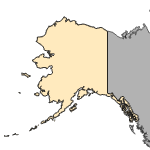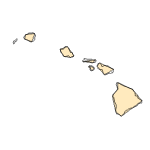Rhinogobius brunneus
(Amur goby)
Fishes
Exotic |
|
Common name: Amur goby
Synonyms and Other Names: Ctenogobius bedfordi, Ctenogobius candidianus, Rhinogobius bergi, Rhinogobius formosanus, Rhinogobius nagoyae, Rhinogobius similis, Rhinogobius sowerbyi, Rhinogobius taiwanus
Taxonomy: available through
www.itis.gov
Identification: Distinguishing features: Fused pelvic fins, which form a suction-cup structure on the chest of the fish; a red or dark line running from the front edge of the eye to the tip of its snout; and breeding males are red or blue with colorful fins. Breeding males have fleshy mouths,colorful fins (white margins on anal and dorsal) and bodies are red and blue.
A number of types that are distinguished primarily by body colouration, but also often occupying different habitat types within the same stream are collectively referred to as the Rhinogobius brunneus species complex. Species in this complex have different life histories and egg sizes (Katoh 1996). At this time, the taxonomy of this species complex is not resolved. Therefore, it is not clear whether the type(s) introduced to the U.S.A. constitute one or more species of Rhinogobius. Specimens have been sent to experts in Japan for identification.
In Japan, the Rhinogobius brunneus complex it thought to comprise at least ten species (Katoh 1996). A key to the eight species in the Rhinogobius brunneus complex from Taiwan is given in Chen and Shao (1996).
Size: To 10 cm TL (Froese and Pauly 2006).
Native Range: Japan, Russian Far East, Taiwan, Korea, China and the Philippines (Froese and Pauly 2006).



|

Alaska |

Hawaii |

Puerto Rico &
Virgin Islands |

Guam Saipan |
Hydrologic Unit Codes (HUCs) Explained
Interactive maps: Point Distribution Maps
Nonindigenous Occurrences:
Rhinogobius brunneus (see “Identification” above) was discovered in the East Fork Lewis River in western Washington state in 2004 and may be reproducing there. Since then, specimens have been collected from the Columbia River and its estuary. Specimen have also been collected from the Sandy River and the Ramsey Wetland in Portland, Oregon (P. Heimowitz, pers. comm.). The Ramsey Wetland is connected to Columbia Slough and the Willamette River.
Table 1. States with nonindigenous occurrences, the earliest and latest observations in each state, and the tally and names of HUCs with observations†. Names and dates are hyperlinked to their relevant specimen records. The list of references for all nonindigenous occurrences of Rhinogobius brunneus are found here.
Table last updated 12/25/2024
† Populations may not be currently present.
Ecology: In their native range, some species in the Rhinogobius brunneus species complex are landlocked, while others have an amphidromous life history, spending portions of their lives in both fresh and saline waters. Spawning occurs in the Spring in freshwaters (Tamada 2000). Males construct nests under stones and entice females to spawn (Katoh 1996). After spawning, males defend and care for the eggs (Katoh 1996; Takahashi and Kohda 2004). Larvae hatch and drift downstream to the sea where they feed and grow. Larval drift occurs nocturnally, and the larvae halt their migration in pools with low flow rates during the day (Iguchi and Mizuno 1990). After a few months in marine waters, juveniles migrate upstream into freshwater for further growth and reproduction, often reaching the headwaters of rivers (Mizuno 1960). The spawning behaviour and larvae of a Korean population of R. brunneus were described by Han et al. (1998).
Means of Introduction: Probably ballast water, but potentially aquarium trade.
Status: Reported to be spawning in the East Fork Lewis River, Washington state.
Impact of Introduction: The impacts of this species are currently unknown, as no studies have been done to determine how it has affected ecosystems in the invaded range. The absence of data does not equate to lack of effects. It does, however, mean that research is required to evaluate effects before conclusions can be made.
References: (click for full references)
Chen, I.-S. and K.-T. Shao. 1996. A taxonomic review of the gobiid fish genus
Rhinogobius Gill 1859 from Taiwan, with descriptions of at least three new species. Zoological studies 35: 200-214.
Froese, R. and D. Pauly (Eds.). 2006. FishBase. World Wide Web electronic publication. www.fishbase.org, version (03/2006).
Iguchi, K. and N. Mizuno. 1990. Diel changes of larval drift among amphidromous gobies in Japan, especially Rhinogobius brunneus. Journal of Fish Biology 37: 255-264.
Katoh, M. 1996. Seasonal variation in gonadal activity of females among four species of freshwater gobies in the Rhinogobius brunneus species complex in Okinawa, Japan. Ichthyological Research 43: 169-174.
Mizuno, N. 1960. Study on a fresh water goby, Rhinogobius brunneus Gill, with a proposition on the relationship between landlocking and speciation of some fresh water gobies in Japan. Memoirs of the College of Science, Kyoto University Service B27: 97-115.
Sal'nikov, V.B. 1998. Anthropogenic migration of fish in Turkmenistan. Journal of Ichthyology 38(8): 591-602.
Han, K.-H., Y.-U. Kim and K.-J. Choe. 1998. Spawning behavior and development of eggs and larvae of the Korea freshwater goby Rhinogobius brunneus (Gobiidae: Perciformes). Journal of the Korean Fisheries Society 31: 114-120.
Takahashi, D. and M. Kohda. 2004. Courtship in fast water currents by a male stream goby (Rhinogobius brunneus) communicates the parental quality honestly. Behavioral Ecology and Sociobiology 55: 431-438.
Tamada, K. 2000. Distributions of the spawning grounds of four amphidromous gobies (Rhinogobius spp.) in the Aizu River, Wakayama Prefecture, Japan. Japanese Journal of Ichthyology 47: 55-59.
Wonham, M. J., J. T. Carlton, G. M. Ruiz and L. D. Smith. 2000. Fishing and ships: relating dispersal frequency to success in biological invasions. Marine Biology 136: 1111-1121.
FishBase Summary
Author:
Schofield, P.J.
Revision Date: 6/30/2009
Peer Review Date: 6/30/2009
Citation Information:
Schofield, P.J., 2024, Rhinogobius brunneus (Temminck and Schlegel, 1845): U.S. Geological Survey, Nonindigenous Aquatic Species Database, Gainesville, FL, https://nas.er.usgs.gov/queries/FactSheet.aspx?SpeciesID=2612, Revision Date: 6/30/2009, Peer Review Date: 6/30/2009, Access Date: 12/26/2024
This information is preliminary or provisional and is subject to revision. It is being provided to meet the need for timely best science. The information has not received final approval by the U.S. Geological Survey (USGS) and is provided on the condition that neither the USGS nor the U.S. Government shall be held liable for any damages resulting from the authorized or unauthorized use of the information.